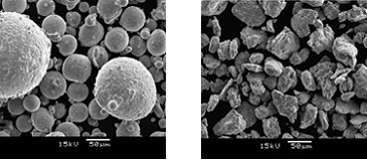
Iron aluminum alloy before and after milling.
Milling alter the particle morphology and, in particular, their internal structure. The section of a ground particle is made up of grains with an average size of 25 nm, which provides the final product with a resistance equivalent to, or indeed greater than, steels that are currently used, with a weight saving of 25 %.
The synthesized powders do not present any risk of nanoparticles being released, as they are pre-integrated into the (e.g. metal) matrix within each grain of powder. Solely a chemical or mechanical attack on the matrix can generate the dissemination of nanocomponents. Thus, these powders can be consolidated in a conventional powder metallurgy workshop to obtain the required objects.
However, if the volume of the nanometric ceramic precursor exceeds 1 %, the composite powder may present a nanometric fraction (< 300 nm) that is not inconsiderable (> 5 %). Under these conditions, the consolidation workshop must be compatible with respect to the nanorisk.


